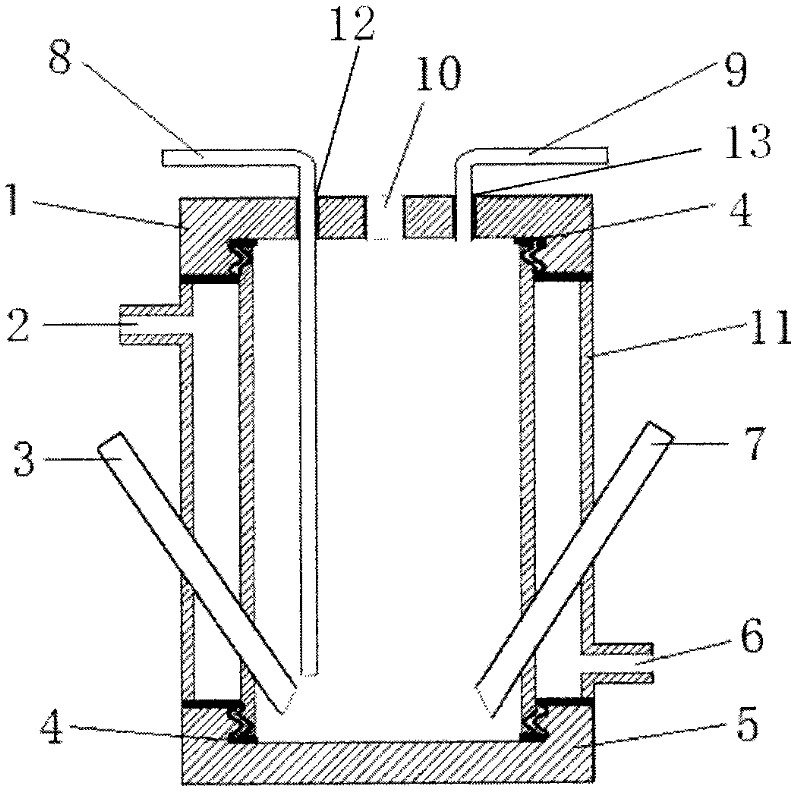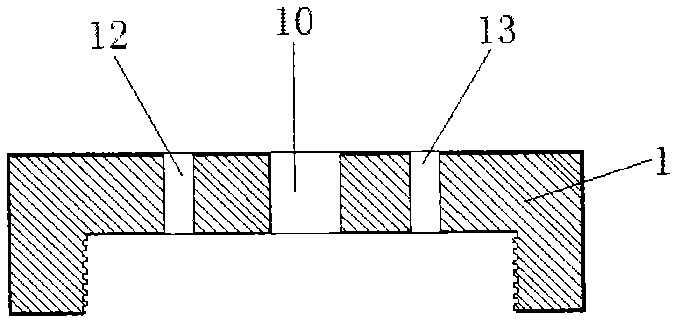Multifunctional electrolytic tank for scanning electrochemical microscope
A technology of scanning electrochemical and electrolytic cells, which is applied in the field of electrochemical experimental devices, can solve the problems that the experimental process cannot be carried out under constant temperature conditions, the device is cumbersome, and the ambient temperature is greatly affected, so as to improve reliability and accuracy, and operate Simple and easy to implement, the effect of improving research efficiency
- Summary
- Abstract
- Description
- Claims
- Application Information
AI Technical Summary
Problems solved by technology
Method used
Image
Examples
Embodiment 1
[0026] Example 1 A multifunctional electrolytic cell for a scanning electrochemical microscope, comprising a concave upper cover 1 and a lower cover 5 with threads I on the inside, and threads II on both ends that match the threads I and containing electrolyte Double cylinder of solution 11 (see image 3 , Image 6 ); The upper cover 1, the lower cover 5, and the double-layer cylinder 11 are connected by threads I and II. The upper part of the side wall of the double-layer cylinder 11 is provided with a water outlet 2, and the bottom of the side wall is respectively provided with a water inlet 6, a side branch pipe I 3 and a side branch pipe II 7; the side branch pipe I 3 and the side branch pipe II 7 are symmetrical Set up and place the reference electrode and counter electrode separately. Both the upper part and the lower part of the double-layer cylinder 11 are connected with the upper cover 1 and the lower cover 5 through the annular sealing gasket 4.
[0027] The upper cov...
Embodiment 2
[0029] Embodiment 2 is a multifunctional electrolytic cell for scanning electrochemical microscope, and the other structure is the same as that in embodiment 1. The middle part of the lower cover 5 is provided with a groove, and two press clips 14 are symmetrically provided on the groove. One of the clamps 14 is connected to an external wire (see Figure 4 ).
[0030] The present invention can be used as a four-electrode system electrolytic cell to study the electrochemical characteristics and surface imaging of indium tin oxide conductive glass modified by functionalized nanoparticles, enzymes, and other thin-film electrodes; in addition, the thin-film electrodes have completed these electrochemical properties. After chemical research, it can be used for research such as surface morphology and microstructure, eliminating the inconvenience of using conventional electrodes for such experiments and improving research efficiency.
Embodiment 3
[0031] Embodiment 3 is a multifunctional electrolytic cell for scanning electrochemical microscope, and the other structure is the same as that in embodiment 1. Wherein the middle of the lower cover 5 is provided with a groove, the center of the groove is provided with a circular hole IV 15; on both sides of the circular hole IV 15 on the groove is symmetrically provided with two press clips 14; one of the press clips 14 and Connect the external wires.
[0032] The invention can be used to study the electrochemical system with conventional electrodes as base electrodes, and can also be used as a link between scanning electrochemical microscopes and other instruments to jointly study complex biochemical systems, and can expand the application range of scanning electrochemical microscopes.
[0033] The upper cover 1 and the lower cover 5 in the above embodiments 1 to 3 are made of polytetrafluoroethylene material, and the double-layer cylinder 11 is made of colorless or brown glass, ...
PUM
 Login to View More
Login to View More Abstract
Description
Claims
Application Information
 Login to View More
Login to View More - R&D
- Intellectual Property
- Life Sciences
- Materials
- Tech Scout
- Unparalleled Data Quality
- Higher Quality Content
- 60% Fewer Hallucinations
Browse by: Latest US Patents, China's latest patents, Technical Efficacy Thesaurus, Application Domain, Technology Topic, Popular Technical Reports.
© 2025 PatSnap. All rights reserved.Legal|Privacy policy|Modern Slavery Act Transparency Statement|Sitemap|About US| Contact US: help@patsnap.com



